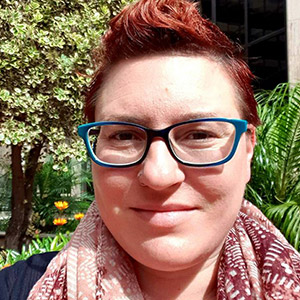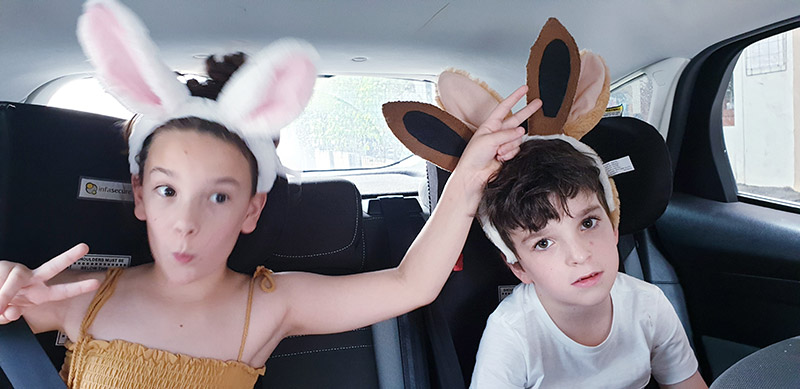 Fleeing the Cudlee Creek fire with the kids… and bunny ears
Fleeing the Cudlee Creek fire with the kids… and bunny ears
SAMHC Featured Blogger:
Ellie Hodges
Executive Director of the Lived Experience Leadership & Advocacy Network
Therapeutic Practitioner
Educator, Consultant
When I sat down to write this post I didn’t know what perspective to write it from: a parent who was home with our children on the day of the Cudlee Creek Fire; as a therapist and someone who lives with the after effects of trauma and knows some stuff about recovery and healing; or as someone actively trying to improve how we understand and support people experiencing distress or mental health issues in our state.
The day of the fire was the last work day of the year for us before an interstate family trip that we were leaving for two days later. I was home with our eight-year old and six-year-old (known as Munch and Mister) and an initial very slow, relaxing morning shifted into a higher gear over the course of a couple of hours.
The smell of smoke while putting washing out made me check the SA Alert app and CFS page. These told me that there was a fire in the Hills. Being an over-thinking worrier who likes to have contingency plans for contingency plans, I did some checking of businesses in the Hills to get a sense of how worried others were by the fire and how it was progressing. It seemed like it was being taken very seriously but was still not anything for us to specifically be concerned about. At this stage though I called my husband and suggested he could finish earlier than his already planned early finish just in case so that we were all together.
As time went by, it became clear from information on the apps, the sight of the smoke and our checking in with each other that we needed to have a more serious talk about what our children and I would do. I was still focused on my husband coming home from the city which he thought was probably not the best idea [which I now totally agree with]. He had some intel from a mate’s mate that if the fire continued heading the way it was, the freeway linking our home in the Adelaide Hills and the city could be closed. Top of my mind was being safe together, so the decision was made that Munch, Mister and I would head down to the city.
Fortunately, we had talked to our children in the past about our plan if there ever was a fire.
I asked them to get dressed and pack a backpack each while I grabbed some things. I told them there was a fire in the Hills, and we were going to go and be with Daddy. It was scary to be packing a suitcase of our laptops, hard drives and important documents while the wind howled around the house on an over 40-degree day in catastrophic fire conditions and a fire was coming our way, even when we were not yet in the evacuate red zone of warnings which did come later.

What do you grab when you’re fleeing a bushfire?
Why, three sets of bunny ears of course!
Despite my own internal jitters and uncertainty of whether things would actually be OK, I reassured Munch and Mister that we were safe, that at that stage our house was fine and that we were just going with the plan we have always had which is very proactive, ‘get out early because life is everything and blocking roads later is unhelpful’. Among all of this we let a couple of key family members, all of whom live interstate, know that ‘Yes there is a fire in our part of the Hills, it is nearby but we are OK. We are leaving’.
We headed down the freeway to the city with no real idea what we would do once we got there. What we decided to do first was get some food for lunch. I took our children to my husband so I could attend a meeting and they continued with our Advent Activity of the day which was donating gifts under the Kmart Wishing Tree. Which all seems so random and very calm looking back now, yet this is not what I was feeling at the time.
Once we were reunited in the late afternoon, having no family to rely on but a couple of offers to hang out at friend’s and knowing that a wind change was starting to have an effect on the fire’s progress toward our town, we made the decision to head to the lobby/ground floor café of a Serviced Apartment Complex. We got more food, watched the news on TV, kept checking the apps, Munch and Mister played with an incomplete chess set and we talked about what we would do next.
After a couple of hours, we decided that it was ‘safe’ to head home. So that is what we did. We went home, assured Munch and Mister that we would not return if we did not think it was safe, told them we would be checking the fire status during the night (which we did by setting alarms) and we put them to bed.
Here’s what I learnt from evacuating because of a bushfire threat:
- There is no way to tell what children value or want to have with them when they need to leave home. This was highlighted when halfway down the freeway Mister pulled some things out of his backpack and asked me to look at him. I turned and saw that he had three sets of bunny ears on his head. What?
- That something as simple as a wind change or the ridge line of Hills decides the path of a fire like this one. That once our town was safe, others were not and that our moments of gratitude were other people’s horror
- That social media can be really helpful and equally unhelpful during times of crisis. There were so many reports from seemingly valid sources that landmarks had been damaged or ruined. For example, it was reported Melba’s Chocolate Factory had burned down but this was not true.
Since the Cudlee Creek Fire, and perhaps because our need to listen in and check on fires continued for the next two weeks as we road tripped to Melbourne and back, Mister continued to ask about the fire near home specifically and also about fires generally. After the Cudlee Creek Fire was declared safe, he asked if we could go for a drive and have a look, saying that ‘it’s part of our community so we should know about it’.
We drove around some of the area which I think was a really helpful thing, particularly for him. It gave us a chance to expand the conversation beyond fear, threat, being unsafe and what was lost. It showed how big the fire ground was and, while the devastation was obvious, it also showed everything that was spared by the CFS and the people who banded together to save property and lives (human and animal). Charred black fences and trees stood right next to homes that were still standing. New growth was starting to shoot through the ground in the smallest of ways. The local property owner installing new fence posts.
I wonder how the communities in the line of the fire are being supported to (re)build, not just the physical environment but the social connections and psychological capacity to keep them moving forward so that the fire is not the sole defining factor of their future?
How does the broader community stay aware enough to learn what we need to learn? How do we collectively and compassionately remember that recovery takes much longer than a month and continues after the media have stopped reporting? How do our services, government, communities and families recognise that the experiences of people directly and indirectly impacted by fire will continue to ebb and flow over time and that support will need to be provided in different ways? How do we get the correct information out there, past the ‘it won’t happen to us’ defence, so that households prepare plans and all residents, including and especially children, know about it?
How do we keep all of this in mind and put things in place to minimise further harm and hurt? I know that the hardest times often begin once people are safe after trauma and when recovery or rebuilding starts to happen, when you have some time to breathe. It can be the place for unravelling and working through while still doing what needs to be done.
People’s lives have been disrupted and will be for some time. How do we look after their mental health and wellbeing without pathologising their responses; creating room for grief and despair, hypervigilance and intrusive memories, weariness at the hurdles and steps needed to get back to ‘normality’, even though it will never be the same again? How do we allow children space to continue to make sense of it without being concerned that they are not coping or are forever affected in a detrimental way?
A few weeks after the fires I was asked if we would continue to stay and live in the Hills. My first and all thoughts since have been, ‘Why wouldn’t we?’ The Hills are our home and we are more ready than ever for any future threat that comes because of the summer that has been. We are not going anywhere.
By Ellie Hodges
Executive Director of the Lived Experience Leadership & Advocacy Network
Therapeutic Practitioner
Educator, Consultant
Ellie Hodges has worked for over 20 years in the community and mental health sectors as a community development lead, therapeutic practitioner, manager, educator, advisor, strategy/policy worker and consultant.
Ellie is the founder and Executive Director of the Lived Experience Leadership & Advocacy Network (LELAN, www.lelan.org.au), which was established in 2017 to amplify the voice, influence and leadership of people with lived experience of distress or mental health issues to drive change. Ellie is an active lived-experience representative, leader and speaker at state and national levels.
She is committed to innovation, social justice, leading together and eating lots of stinky cheese.
SAMHC Featured Bloggers
The SAMHC presents our series of guest featured bloggers who generously share their personal thoughts and experiences of mental health and wellbeing.


